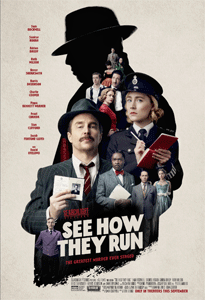As a fan of Agatha Christie and of comedy that points out the absurdities of all human beings, I found “See How They Run” to be an absolute delight. Screenwriter Mark Chappell, a British TV writer whose talent I am shamefully only now discovering, understands “The Mousetrap’s” place in history but also knows the author’s sense of humor. If Christie were alive today, she’d love this film.
The Christie connection is merely a bonus, though. “See How They Run” is driven by Sam Rockwell and Saoirse Ronan, whose comic timing is perfect as they play Inspector Stoppard and Constable Stalker.
The Fifties trappings are wonderfully in place. Every frame is like a beautiful pastel painting, and even when the action gets chaotic – splitting into two screens – director Tom George maintains a crisp feel. This production is as gorgeous as “The Marvelous Mrs. Maisel,” but not as show-offy.
“See How They Run” (2022)
Director: Tom George
Writer: Mark Chappell
Stars: Sam Rockwell, Saoirse Ronan, Adrien Brody
Stoppard and Stalker
The technical side is tasty, but bad films can be technically strong. This is a great one, though; I come back to the Stoppard-Stalker interactions. He wants to take a brief nap in the car, so he asks her to find a phone booth, call the station and get the address of the next witness on their interview list.
Adorably, she’s such a go-getter that she has already written down the address. Out of excuses, he rouses himself to keep working. The subtle work by Rockwell (great in everything) and Ronan (better than I’ve ever seen her before) is masterful; they know why this stuff is funny, but they don’t oversell it.
“See How They Run” gets grander for the conclusion, incorporating physical comedy when the theater owner tries to nudge the butler closer to a rifle. He resists; he’s not up for risking himself. Earlier physical comedy comes when Stoppard gets a bout of sneezes, reminding me of Christie’s sneeze-based gag in “Murder at the Vicarage.”
Chappell doesn’t make the cops into clowns; he keeps their feet on the ground. The veteran Stoppard is good at his job, and Stalker is an amateur; she can’t resist putting absolutely everything in her notebook. In the broadest gag, she overthinks things so much that she fingers her partner/mentor for the crime.
That crime is the murder of Adrien Brody’s Leo Kopernick backstage at “The Mousetrap.” Brody is his usual excellent self in playing a charismatic but smarmy film director; Leo aims to adapt the play to the screen. The deceased Leo stays in the narrative thanks to robust flashbacks. These don’t hamper the story’s forward momentum, since they reveal new information.

A meta premise
Let me pause for a quick note about the premise, which is extremely meta. “The Mousetrap” ran consecutively at London’s West End from 1952 until the pandemic. Christie adapted it into a short story, which is how I know the yarn. It’s a standard whodunit, thus allowing for Chappell to make fun of the tropes. His cheekiness wouldn’t play as well if we were dealing with one of her masterpieces.
Christie stipulated “The Mousetrap” couldn’t be adapted into a film until six months after the play’s original run had ended. (She didn’t expect it to run for 68 years.) I don’t know if “See How They Run” is a workaround because the filmmakers truly weren’t allowed to make “The Mousetrap” or if they were always thinking comedically.
In a meta gag, the theater owner is always quick to note that Christie was “inspired by – loosely” real-world events. It’s potentially important for legal reasons that “The Mousetrap” isn’t “based on” anything real. The same (winkingly) goes for “See How They Run.”
Final items from the notebook
A quick note about the casting: It’s color-blind. Black folks didn’t have such prominent spots in the Fifties British theater scene as the film suggests, and Christie’s husband Max Mallowan (played by a black actor here) was white. I noticed the color-blind casting but was not distracted by it. It might not be the right choice in a sober historical piece, but in a fictional romp, it’s a rather nice touch.
If there’s the slightest ding to “See How They Run,” it’s that the murder-mystery is definitely backgrounded. Upon the reveal, you’ll see it was solvable if you’re eagle-eyed. But this isn’t a dual-genre balance like “Knives Out”; the point is always the comedy.
When a movie is this funny, I can’t argue with the choice.
For an index of RFMC’s Agatha Christie reviews, visit our Agatha Christie Zone.

